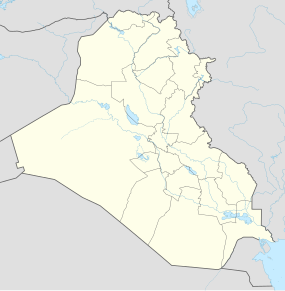Tell Shemshara
| Shusharra | |
| Location | Iraq |
|---|---|
| Region | Sulaymaniyah Governorate |
| Coordinates | 36°12′03″N 44°56′18″E / 36.200709°N 44.938253°E |
| Type | tell |
| Length | 270 m (890 ft) (lower mound) |
| Width | 60 m (200 ft) (main mound) |
| Height | 19 m (62 ft) (main mound), 6 m (20 ft) (lower mound) |
| History | |
| Periods | Hassuna, Middle Bronze Age, Islamic |
| Site notes | |
| Excavation dates | 1957–1959, 2012 |
| Archaeologists | J. Eidem, H. Ingholt, J. Læssøe, A. al-Qadir at-Tekrîti |
| Condition | periodically flooded by Lake Dukan |
Tell Shemshara is an Assyrian archaeological site located along the Little Zab in Sulaymaniyah Governorate, northeastern Iraq. The site was excavated between 1957 and 1959 by Danish and Iraqi archaeologists and was inundated by Lake Dukan until recently. The excavations showed that the site was occupied, although not continuously, from the Hassuna period (early sixth millennium BCE) until the 14th century CE. A small archive recovered from the Middle Bronze Age layers (early second millennium BCE) revealed that, at least in that period, the site was called Shusharra and was the capital of a small, semi-independent polity called māt Utêm or "land of the gatekeeper" ruled by a man called Kuwari.
The site was first recorded in 1955 during an archaeological survey of the Ranya Plain, which was to be flooded by the reservoir of the planned Dukan Dam. In 1957, a Danish team of archaeologists started a rescue excavation because the site would be flooded by Lake Dukan once the Dukan Dam would be finished. The Danish excavation was directed by Professors Harold Ingholt, who also excavated the citadel mound of Hama, and Jørgen Læssøe. It was funded by the Carlsberg Foundation and the Danish Government Foundation for the Promotion of Research. The excavations were continued in 1958 and 1959 by Iraqi archaeologists of the State Board of Antiquities and Heritage (SBAH) under the direction of Abd al-Qadir at-Tekrîti. The excavations have revealed that the site was occupied at least from the Hassuna period onward and the latest occupation phase dates to the 12th–14th centuries CE. The objects found during the Danish excavation were divided between the National Museum of Iraq and the National Museum of Denmark. So far, the prehistoric material of the Hassuna layers and the majority of the archives from the second millennium BCE have been published.
...
Wikipedia

